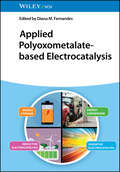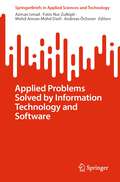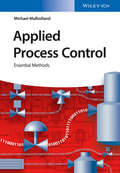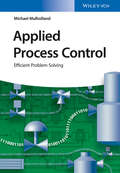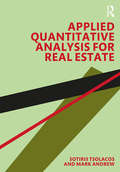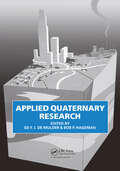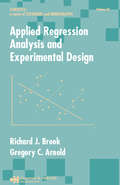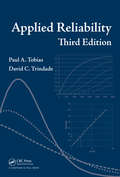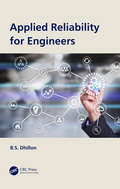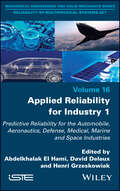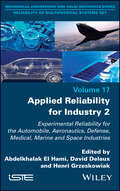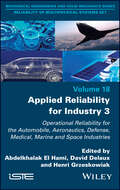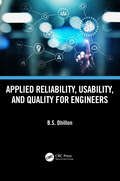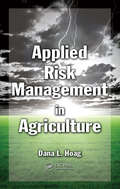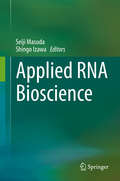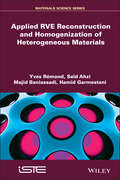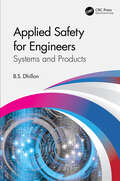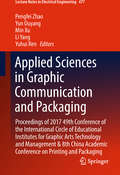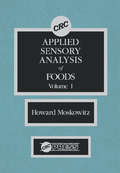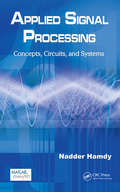- Table View
- List View
Applied Polymer Rheology
by Marianna KontopoulouExplore polymer rheology from an industrial standpoint Presenting state-of-the-art polymer rheology as observed by well-recognized authors, Applied Polymer Rheology: Polymeric Fluids with Industrial Applications is designed to help readers understand the relationship between molecular structure and the flow behavior of polymers. In particular, it focuses on polymeric systems that elicit special attention from industry. Providing a comprehensive overview of the rheological characteristics of polymeric fluids, the book bridges the gap between theory and practice/application, enabling readers to see the connection between molecular structure and the behavior of the polymers studied. Beginning with a discussion of the properties, processability, and processing aids of specific polymers, later chapters examine filled polymers and composites, and the theoretical framework upon which their analysis is based. Various systems containing microstructure are presented subsequently, with the final chapter introducing paste extrusion of polytetrafluoroethylene paste. An invaluable reference guide that covers the literature and vast array of technical approaches to polymer rheology, Applied Polymer Rheology's coverage of polymeric fluids of interest to industry make it an essential resource for plastics, polymer, and chemical engineers, materials scientists, polymer chemists, and polymer physicists to use when interpreting findings and planning experiments.
Applied Polymer Science
by Ulf W. Gedde Mikael S. Hedenqvist Minna Hakkarainen Fritjof Nilsson Oisik DasThis companion volume to “Fundamental Polymer Science” (Gedde and Hedenqvist, 2019) offers detailed insights from leading practitioners into experimental methods, simulation and modelling, mechanical and transport properties, processing, and sustainability issues. Separate chapters are devoted to thermal analysis, microscopy, spectroscopy, scattering methods, and chromatography. Special problems and pitfalls related to the study of polymers are addressed. Careful editing for consistency and cross-referencing among the chapters, high-quality graphics, worked-out examples, and numerous references to the specialist literature make “Applied Polymer Science” an essential reference for advanced students and practicing chemists, physicists, and engineers who want to solve problems with the use of polymeric materials.
Applied Polyoxometalate-Based Electrocatalysis
by Diana M. FernandesWell-researched reference on stable alternative electrocatalysts and electrode materials with the potential to transform chemistry and processes in sensor- and energy-related technologies Applied Polyoxometalate-based Electrocatalysis delivers an overview of the variety of efficient applications of free POM and POM-based (nano)composites as exciting materials in the field of electrocatalysis. With a variety of sizes, shapes, composition, and physical and chemical properties, these composites have important properties, such as the ability to undergo reversible multivalence reductions/oxidations, leading to the formation of mixed-valence species, which brings about favorable electrocatalytic properties with regard to several electrochemical processes. Edited by a highly qualified independent researcher internationally recognized for her contributions to materials for electrochemical energy-related reactions, Applied Polyoxometalate-based Electrocatalysis includes information on: General methodologies used in the preparation of free POMs and POM-based nanocomposites and different strategies employed in electrode modification Role of POM-modified electrodes in oxidative and reductive electrocatalysis, including the detection/sensing of several (bio)molecules of interest and carbon dioxide electroreduction Application of POM-based (nano)composites, including the oxygen reduction reaction relevant to fuel cells, the oxygen and hydrogen evolution reactions, and batteries and supercapacitors Applied Polyoxometalate-based Electrocatalysis is an essential reference on the subject for chemists, material scientists, chemical engineers, and institutions involved in work related to free POM and POM-based (nano)composites.
Applied Problems Solved by Information Technology and Software (SpringerBriefs in Applied Sciences and Technology)
by Azman Ismail Fatin Nur Zulkipli Mohd Amran Mohd Daril Andreas ÖchsnerThis book explores a dynamic landscape where cutting-edge technologies are revolutionizing various domains. This captivating book delves into the advancements in security, communication, and environmental management, highlighting their profound impact on society. The developments bridge the gap between human needs and technological innovation. Readers will uncover the fascinating world of IoT-driven devices that seamlessly integrate into our lives, ensuring enhanced safety and communication efficiency. This book is a must-read for technology enthusiasts, researchers, and anyone curious about the transformative power of technology in shaping our present and future.
Applied Process Control: Essential Methods
by Michael MulhollandThe basic working knowledge for the practicing control engineer in industry, offered here as a handy deluxe edition comprising two volumes each devoted to methods and practical problems. Focusing on their practical implementation, the methods volume provides readers with rapid access to process modelling and control, while including the theoretical background necessary. Throughout, the essential knowledge is built up from chapter to chapter, such that by the end readers have the means to design simple controllers on the basis of their own models, and to use more detailed models to test them. With its clarity and simplicity of presentation, and illustrated by more than 200 diagrams, the volume supports self-study and teaches readers how to apply the appropriate method for the application required and to handle problems in process control. Bridging theory and practice, the second volume contains over 200 practical exercises and their solutions to train problem-solving abilities in process control. The problems were developed by the author during his many years of teaching at university and are kept brief, taken from the fields of instrumentation, modeling, plant control, control strategy design and stability of control. The algorithm flows and codes, which are mostly based on MATLAB?, are given in many cases and allow for easy translation into applications. With a clarity and simplicity of presentation, the two volumes are similarly structured for easy orientation.
Applied Process Control: Efficient Problem Solving
by Michael MulhollandBridging theory and practice, this book contains over 200 practical exercises and their solutions, to develop the problem-solving abilities of process engineers. The problems were developed by the author during his many years of teaching at university and are kept brief, taken from the fields of instrumentation, modelling, plant control, control strategy design and stability of control. The algorithm flows and codes, which are mostly based on MATLAB?, are given in many cases and allow for easy translation into applications. Since the text is structured according to "Applied Process Control: Essential Methods", all of the necessary background information on the underlying methods can be easily and quickly found in this accompanying book.
Applied Quantitative Analysis for Real Estate
by Sotiris Tsolacos Mark AndrewTo fully function in today’s global real estate industry, students and professionals increasingly need to understand how to implement essential and cutting-edge quantitative techniques. This book presents an easy-to-read guide to applying quantitative analysis in real estate aimed at non-cognate undergraduate and masters students, and meets the requirements of modern professional practice. Through case studies and examples illustrating applications using data sourced from dedicated real estate information providers and major firms in the industry, the book provides an introduction to the foundations underlying statistical data analysis, common data manipulations and understanding descriptive statistics, before gradually building up to more advanced quantitative analysis, modelling and forecasting of real estate markets. Our examples and case studies within the chapters have been specifically compiled for this book and explicitly designed to help the reader acquire a better understanding of the quantitative methods addressed in each chapter. Our objective is to equip readers with the skills needed to confidently carry out their own quantitative analysis and be able to interpret empirical results from academic work and practitioner studies in the field of real estate and in other asset classes. Both undergraduate and masters level students, as well as real estate analysts in the professions, will find this book to be essential reading.
Applied Quaternary Research
by ED F.J.DE MULDER Bob P. HagemanProceedings of a symposium at the 1987 INQUA Congress, Ottawa, Aug. 1987. Contributions present the application of quaternary studies to land use planning and development. No index. Annotation copyright Book News, Inc. Portland, Or.
Applied Regression Analysis and Experimental Design (Statistics: A Series Of Textbooks And Monographs #62)
by Richard J. Brook Gregory C. ArnoldFor a solid foundation of important statistical methods, the concise, single-source text unites linear regression with analysis of experiments and provides students with the practical understanding needed to apply theory in real data analysis problems.Stressing principles while keeping computational and theoretical details at a manageable level, Applied Regression Analysis and Experimental Design features an emphasis on vector geometry and least squares to unify and provide an intuitive basis for most topics covered… abundant examples and exercises using real-life data sets clearly illustrating practical of data analysis…essential exposure to MINITAB and GENSTAT computer packages , including computer printouts…and important background material such as vector and matrix properties and the distributional properties of quadratic forms.Designed to make theory work for students, this clearly written, easy-to-understand work serves as the ideal texts for courses Regression, Experimental Design, and Linear Models in a broad range of disciplines. Moreover, applied statisticians will find the book a useful reference for the general application of the linear model.
Applied Reliability
by Paul A. Tobias David TrindadeSince the publication of the second edition of Applied Reliability in 1995, the ready availability of inexpensive, powerful statistical software has changed the way statisticians and engineers look at and analyze all kinds of data. Problems in reliability that were once difficult and time consuming even for experts can now be solved with a few well
Applied Reliability Engineering and Risk Analysis
by Alex Karagrigoriou Anatoly Lisnianski Andre V. Kleyner Ilia B. FrenkelThis complete resource on the theory and applications of reliability engineering, probabilistic models and risk analysis consolidates all the latest research, presenting the most up-to-date developments in this field.With comprehensive coverage of the theoretical and practical issues of both classic and modern topics, it also provides a unique commemoration to the centennial of the birth of Boris Gnedenko, one of the most prominent reliability scientists of the twentieth century.Key features include:expert treatment of probabilistic models and statistical inference from leading scientists, researchers and practitioners in their respective reliability fieldsdetailed coverage of multi-state system reliability, maintenance models, statistical inference in reliability, systemability, physics of failures and reliability demonstrationmany examples and engineering case studies to illustrate the theoretical results and their practical applications in industryApplied Reliability Engineering and Risk Analysis is one of the first works to treat the important areas of degradation analysis, multi-state system reliability, networks and large-scale systems in one comprehensive volume. It is an essential reference for engineers and scientists involved in reliability analysis, applied probability and statistics, reliability engineering and maintenance, logistics, and quality control. It is also a useful resource for graduate students specialising in reliability analysis and applied probability and statistics.Dedicated to the Centennial of the birth of Boris Gnedenko, renowned Russian mathematician and reliability theorist
Applied Reliability for Engineers
by B.S. DhillonEngineering systems and products are an important element of the world economy and each year billions of dollars are spent to develop, manufacture, operate, and maintain systems and products around the globe. Because of this, global competition is requiring reliability professionals to work closely with other departments involved in engineering development during the product design and manufacturing phase. Applied Reliability for Engineers is an attempt to meet the need for a single volume that addresses a wide range of applied reliability topics. The material is treated in such a manner that the reader will require no previous knowledge to understand the text. The sources of most of the information presented are given in a reference section at the end of each chapter. At appropriate places, the book contains examples along with their solutions. At the end of each chapter there are numerous problems to test reader comprehension. This volume is thus suitable for use as a textbook as well as for reference. Applied Reliability for Engineers is useful to design professionals, system engineers, reliability specialists, graduate and senior undergraduate students, researchers and instructors of reliability engineering, and engineers-at-large.
Applied Reliability for Industry 1: Predictive Reliability for the Automobile, Aeronautics, Defense, Medical, Marine and Space Industries
by Abdelkhalak El Hami David Delaux Henri GrzeskowiakApplied Reliability for Industry 1 illustrates the multidisciplinary state-of-the-art science of predictive reliability. Many experts are now convinced that reliability is not limited to statistical sciences. In fact, many different disciplines interact in order to bring a product to its highest possible level of reliability, made available through today's technologies, developments and production methods. These three books, of which this is the first, propose new methods for analyzing the lifecycle of a system, enabling us to record the development phases according to development time and levels of complexity for its integration. Predictive reliability, as particularly focused on in Applied Reliability for Industry 1, examines all the engineering activities used to estimate or predict the reliability performance of the final mechatronic system.
Applied Reliability for Industry 2
by Abdelkhalak El Hami David Delaux Henri GrzeskowiakApplied Reliability for Industry 2 illustrates the multidisciplinary state-of-the-art science of experimental reliability. Many experts are now convinced that reliability is not limited to statistical sciences. In fact, many different disciplines interact in order to bring a product to its highest possible level of reliability, made available through today's technologies, developments and production methods. These three books, of which this is the second, propose new methods for analyzing the lifecycle of a system, enabling us to record the development phases according to development time and levels of complexity for its integration. Experimental reliability, as advanced in Applied Reliability for Industry 2, examines all the tools and testing methods used to demonstrate the reliability of the final mechatronic system.
Applied Reliability for Industry 3
by Abdelkhalak El Hami David Delaux Henri GrzeskowiakApplied Reliability for Industry 3 illustrates the multidisciplinary state-of-the-art science of operational reliability. Many experts are now convinced that reliability is not limited to statistical sciences. In fact, many different disciplines interact in order to bring a product to its highest possible level of reliability, made available through today’s technologies, developments and production methods. These three books, of which this is the third, propose new methods for analyzing the lifecycle of a system, enabling us to record the development phases according to development time and levels of complexity for its integration. Operational reliability, as presented in Applied Reliability for Industry 3, verifies the reliability performance of the mechatronic system in real life through an analysis of field data.
Applied Reliability, Usability, and Quality for Engineers
by B.S. DhillonGlobal competition is forcing reliability and other professionals to work closely during the product design and manufacturing phase. Because of this collaboration, reliability, usability, and quality principles are being applied across many diverse sectors of the economy. This book offers the principles, methods, and procedures for these areas in one resource. This book brings together the areas of reliability, usability, and quality for those working in diverse areas to allow them to be exposed to activities that can help them perform their tasks more effectively. This is the only book that covers these areas together in this manner and written in such a way that no previous knowledge is required to understand it. The sources of the material presented are included in the reference section at the end of each chapter along with examples and solutions to test reader comprehension. Applied Reliability, Usability, and Quality for Engineers is useful to design, manufacturing, and systems engineers, as well as manufacturing managers, reliability, usability and, quality specialists. It can also be helpful to graduate, senior undergraduate students, and instructors.
Applied Risk Management in Agriculture
by Dana L. HoagDefining the fundamentals of building a risk management plan, Applied Risk Management in Agriculture uses strategic management to organize the process of risk management. A time-tested procedure inside and outside the business community, this technique provides an ideal platform for organizing risk.Making complex principles easily accessible to stu
Applied RNA Bioscience
by Seiji Masuda Shingo IzawaThe focus of this book is to introduce up-to-date information on applications and practical use of RNA for agriculture, biotechnology and medicine.<P><P> It provides unique ideas, tools, and methods in detail from a variety of scientific and technical disciplines. RNA science has progressed enormously in recent decades, and vast amounts of information on RNA functions and their regulatory mechanisms are becoming available. Such a progress opened the door to an age of practical application of RNA in many fields including agriculture, plant science, medical science, brewing and fermentation technology, and material production. <P>This book inspires its readership and contributes to not only expansion in application of RNA but also to basic research.
Applied RVE Reconstruction and Homogenization of Heterogeneous Materials
by Majid Baniassadi Hamid Garmestani Yves Rémond Said AhziStatistical correlation functions are a well-known class of statistical descriptors that can be used to describe the morphology and the microstructure-properties relationship. A comprehensive study has been performed for the use of these correlation functions for the reconstruction and homogenization in nano-composite materials. Correlation functions are measured from different techniques such as microscopy (SEM or TEM), small angle X-ray scattering (SAXS) and can be generated through Monte Carlo simulations. In this book, different experimental techniques such as SAXS and image processing are presented, which are used to measure two-point correlation function correlation for multi-phase polymer composites. Higher order correlation functions must be calculated or measured to increase the precision of the statistical continuum approach. To achieve this aim, a new approximation methodology is utilized to obtain N-point correlation functions for multiphase heterogeneous materials. The two-point functions measured by different techniques have been exploited to reconstruct the microstructure of heterogeneous media. Statistical continuum theory is used to predict the effective thermal conductivity and elastic modulus of polymer composites. N-point probability functions as statistical descriptors of inclusions have been exploited to solve strong contrast homogenization for effective thermal conductivity and elastic modulus properties of heterogeneous materials. Finally, reconstructed microstructure is used to calculate effective properties and damage modeling of heterogeneous materials.
Applied Safety for Engineers: Systems and Products
by B.S. DhillonGlobal competition and other factors are forcing manufacturers to produce highly safe engineering systems and products. This book meets the needs for product designers, systems engineers, and safety engineers that work together and need a single resource which considers all three areas when designing new products and systems that they can refer to. Applied Safety for Engineers: Systems and Products serves as a comprehensive resource offering a wide range of safety topics when involved with product design, engineering system analysis, and engineering maintenance. Examples along with their solutions are placed at the end of each chapter to test reader comprehension. The book facilitates the importance for product designers, safety, and systems engineering professionals to work closely during the product design phase so they can understand each other’s discipline. Written in a manner that readers do not need any previous knowledge on the subject, the book offers many sources for further reading at the end of each chapter. This book will be useful to product designers, system engineers, safety specialists, graduate and senior undergraduate students, researchers and manufacturers, industrial engineers, safety engineers, and engineers-at-large.
Applied Science: Knowledge, Modernity, and Britain's Public Realm (Science in History)
by Robert BudFor almost two centuries, the category of 'applied science' was widely taken to be both real and important. Then, its use faded. How could an entire category of science appear and disappear? By taking a longue durée approach to British attitudes across the nineteenth and twentieth centuries, Robert Bud explores the scientific and cultural trends that led to such a dramatic rise and fall. He traces the prospects and consequences that gave the term meaning, from its origins to its heyday as an elixir to cure many of the economic, cultural, and political ills of the UK, eventually overtaken by its competitor, 'technology'. Bud examines how 'applied science' was shaped by educational and research institutions, sociotechnical imaginaries, and political ideologies and explores the extent to which non-scientific lay opinion, mediated by politicians and newspapers, could become a driver in the classification of science.
Applied Sciences in Graphic Communication and Packaging: Proceedings of 2017 49th Conference of the International Circle of Educational Institutes for Graphic Arts Technology and Management & 8th China Academic Conference on Printing and Packaging (Lecture Notes in Electrical Engineering #477)
by Min Xu Li Yang Yun Ouyang Pengfei Zhao Yuhui RenThis book includes a selection of reviewed papers presented at the 49th Conference of the International Circle of Educational Institutes for Graphic Arts Technology and Management & 8th China Academic Conference on Printing and Packaging, which was held on May 14-16, 2017 in Beijing, China. The conference was jointly organized by the Beijing Institute of Graphic Communication, China Academy of Printing Technology, and International Circle of Educational Institutes for Graphic Arts Technology and Management. With eight keynote talks and 200 presented papers on graphic communication and packaging technologies, the event attracted more than 400 scientists. The proceedings cover the latest advances in color science and technology; image processing technology; digital media technology; digital process management technology in packaging; packaging, etc. , and will be of interest to university researchers, R&D engineers and graduate students in the graphic arts, packaging, color science, image science, material science, computer science, digital media and network technology.
Applied Second Law Analysis of Heat Engine Cycles
by S. Can GülenApplied Second Law Analysis of Heat Engine Cycles offers a concise, practical approach to one of the two building blocks of classical thermodynamics and demonstrates how it can be a powerful tool in the analysis of heat engine cycles. Including real system models with the industry-standard heat balance simulation software, the Thermoflow Suite (GTPRO/MASTER, PEACE, THERMOFLEX) and Excel VBA, the book discusses both the performance and the cost. It also features both calculated and actual examples for gas turbines, steam turbines, and simple and combined cycles from major original equipment manufacturers (OEMs). In addition, novel cycles proposed by researchers and independent technology developers will also be critically examined. This book will be a valuable reference for practicing engineers, enabling the reader to approach the most difficult thermal design and analysis problems in a logical manner.
Applied Sensory Analy of Foods
by Howard R. MoskowitzThis book extends the analysis of perception of food qualities to the area of multivariate methods. It presents the field of sensory analysis and gives the reader first-hand descriptions of research approaches and applications.
Applied Signal Processing: Concepts, Circuits, and Systems
by Nadder HamdyClassical signal processing techniques are based primarily on the analog nature of all signals. However, the continuously improving performance of digital circuitry and processors has prompted a switch to digital signal processing techniques rather than the traditional analog ones.Applied Signal Processing recognizes the linkage between


